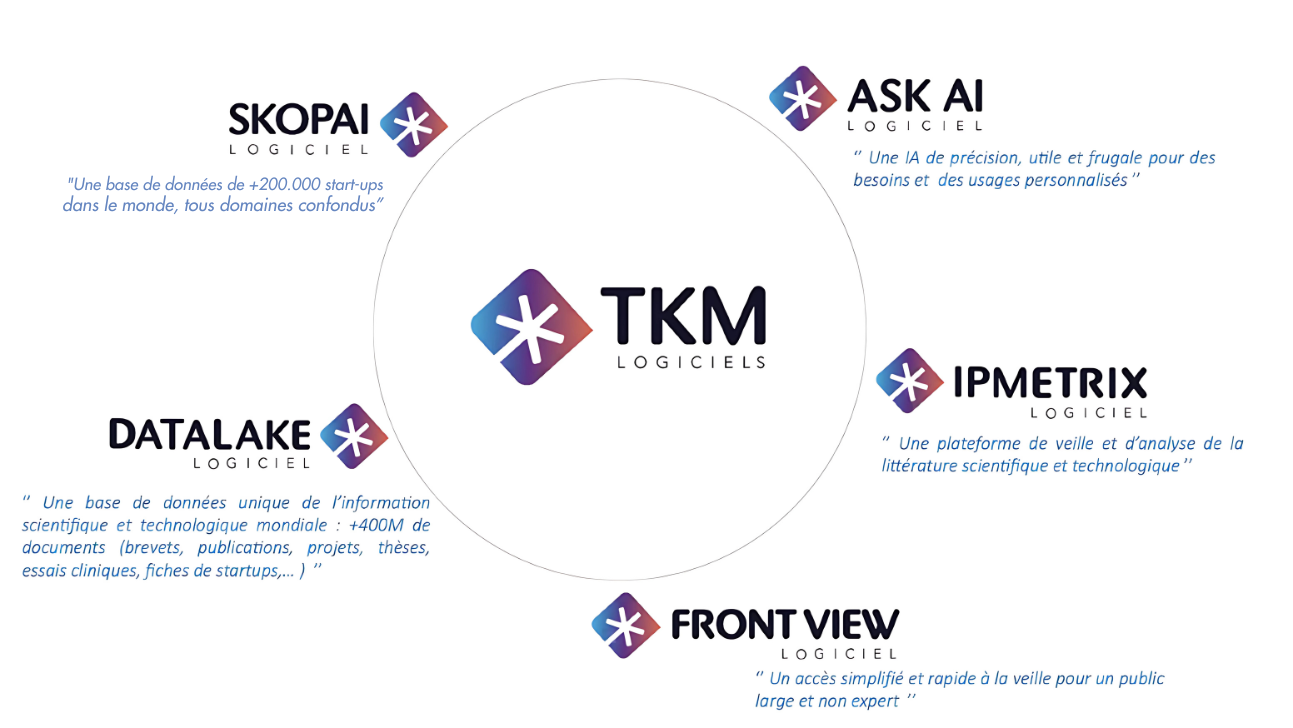The monitoring approach has become essential for analyzing open information which is currently growing very strongly. This leaves real prospects for SMEs and start-ups who have a vital need for organized monitoring.
In a world where information is the key to competitiveness and where strategic and technological monitoring has become a necessity, controlling the costs of access to quality raw information has become a major challenge.
By way of illustration and with regard to patent databases, companies continue to devote budgets, in our opinion, far too high to access this information, yet it is increasingly often accessible free of charge or at much more reasonable costs.
Whether you are an SME manager or a monitoring analyst, you are undoubtedly facing this problem and must control a budget dedicated to monitoring which is limited.
In this context, our software suite offers a real opportunity for rapid access to a multitude of open data sources and global coverage. This allows you to implement a monitoring process on the progress of your competitors, markets, your customers, or even new technologies.
At TKM we have also created IZINOV solutions which provide a truly accessible alternative to SMEs or startups.
 MONITORING APPROACH: A NOT SO COMPLICATED BUT ESSENTIAL PROCESS
MONITORING APPROACH: A NOT SO COMPLICATED BUT ESSENTIAL PROCESS
Whatever your sector of activity, technological monitoring and strategic monitoring are more essential than ever. They allow you to stay at the forefront of innovation , monitor the competition and detect opportunities in the market .
However, this monitoring approach is increasingly becoming professionalized, both in terms of tools and methodology. Indeed, the abundance of information that we have been overwhelmed with since the rise of the Internet has led us to believe that being well informed was easy. It's the end of a myth! And we must collectively relearn the basics of effective monitoring, that is to say monitoring that usefully feeds the decision-making and strategic management process.
Accessing data is one thing. Classifying and analyzing this data is much better. And sharing them to nourish a process of collective intelligence internally is the goal.
How do companies approach monitoring today?
SMEs, in particular, often devote more resources to monitoring than they themselves believe.
But due to a lack of organization and effective tools, monitoring is limited to decentralized or even individual activities without having an organized, collective and methodical monitoring strategy.
Everyone monitors their networks, schedules Google alerts, reads a few specialized newsletters or follows up on a few key information sources. But there is nothing to consolidate this monitoring at the level of a strategic management process, and a lot of important information can remain under the radar for a long time.
 OBSTACLES TO AN EFFECTIVE MONITORING APPROACH
OBSTACLES TO AN EFFECTIVE MONITORING APPROACH
Several factors may contribute to this finding.
Do you recognize yourself in the following points?
- Lack of resources : SMEs often have limited resources to devote to monitoring. Of course, time is money. But also a missed opportunity…
- Cost of databases : Corollary to the previous point, access to specialized and paid databases is often prohibitively expensive. And it's even worse to pay a lot to access a database that won't be used... Not to mention the risk that this investment won't pass the next budget review.
- Lack of training : Monitoring is not only a question of access to information, but also of methods and techniques to analyze this information and quickly make it useful. Due to lack of time, lack of manpower, time-sharing subcontracting can be a solution.
- Lack of analysis tools : Even with the right data sources, the volume of information is often too large to process manually. This requires filtering and analysis tools. These tools will also allow you to capitalize on this knowledge base over time, in order to make it a real company asset.
- Read also – Weak signals: how not to miss them during monitoring work?
Monitoring is often perceived as a luxury or a secondary task , or even worse, a distraction... Even though it has its place more than ever at the heart of the company's strategic management.
But there is no fatality!
The cost and complexity associated with accessing and analyzing paid databases are obstacles, but they are not insurmountable. There are indeed solutions to make monitoring more efficient and less costly , as we will see later.
 DATABASES: ESSENTIAL TOOLS FOR MONITORING
DATABASES: ESSENTIAL TOOLS FOR MONITORING
BDD: what are we talking about and why is it useful?
All research work, all conferences, all claims in the form of patents or trademarks, all collaborative projects (in France, but also in Europe or around the world), all developments in terms of standards... Are published and available online in searchable databases. This data is the raw material for any technological monitoring or strategic monitoring process. Unlike general search engines, databases offer reliable and detailed content . Their structuring also allows for great finesse in questioning, which is very valuable for monitoring.
Once the right “search strategy” has been developed and validated, monitoring can be easily automated.
The good news is that these accesses are increasingly open and free.
The bad news is that this does not solve the problem of the quantity of information to be processed, on the contrary…
The monitoring analyst is often overwhelmed by the mass of raw information to sort. Even with a very refined search strategy, it is not uncommon for 80 to 90% of the information reported by these automated monitoring to turn out to be irrelevant...
The solution which would consist of being more restrictive on collection is also not satisfactory because it runs the risk of missing out on relevant information..
All these tasks take the person in charge of monitoring away from truly useful activities that should normally punctuate their days: broadcasting, creating collective intelligence, investigating subjects of interest in greater depth or digging into weak signals... In short, all this which is what makes the job of watchman so special, but also what gives it its strategic importance. On this subject, AI can help you save precious time…
The cost of accessing databases
Free or paid?
If the use of paid databases can be justified (coverage, speed, advanced search functionalities, etc.), it is clearly not an obligatory point of passage , especially for an SME which wants to professionalize its monitoring.
Between doing nothing in terms of monitoring because it is too expensive – which amounts to driving without insurance under the pretext that you have never had an accident – and spending a fortune on access to raw data, there is fortunately a happy medium.
In terms of patents, for example, there are free services operated by the Offices themselves and which provide a first level of access that is entirely satisfactory to initiate a competitive and technological monitoring process.
If it can sometimes prove useful to then move to paid bases, in particular to benefit from additional functionalities (unloading time, sorting and filtering functions), you can also find very satisfactory solutions at reasonable prices, at from 3000 euros per year.
A quick economic analysis of the expected gain will quickly inform your decision.
The cost may vary depending on different factors, some examples of which are:
- Number of users : this will be the case for most databases
- Data coverage : the more complete the database is in terms of journals, temporal or geographic coverage, the more expensive it is likely to be.
- Updates : Some databases offer faster updates than others
- Advanced features : often useless because they cannot replace the multi-source analysis tools that you will have to use later, these expensive functions are sometimes offered as an option.
 BEYOND ACCESS TO BBD
BEYOND ACCESS TO BBD
To be effective you won't need just one database, but more likely 2 or 3... and sometimes many more (if you also monitor collaborative projects). Added to this will be everything you collect on the Internet (press, competitor sites, etc.).
Very quickly, you will therefore need to group all this information (once filtered or with a view to filtering it) into a single analysis tool . Otherwise, you will be condemned to carry out as many analyzes as you have input sources, to ultimately achieve an impossible synthesis.
Especially with the growing mass of information, it is imperative to have tools to automate the process of collecting and initial sorting of information and to analyze and structure the results of this monitoring .
Without these tools, even access to the most comprehensive databases will quickly become useless.
 WITH OUR SOFTWARE SUITE, BENEFIT FROM UNIQUE ACCESS TO ALL GLOBAL DATABASES
WITH OUR SOFTWARE SUITE, BENEFIT FROM UNIQUE ACCESS TO ALL GLOBAL DATABASES
Database pooling: the power to group your analyzes in a single space
One of the great strengths of our tools is that they allow the pooling and grouping into a single database of all the results from all the global databases that you wish to integrate into your monitoring or analyses . You thus have unique access that opens the doors to a multitude of specialized databases, free or paid, ranging from patents to scientific publications and collaborative projects, to which you will also add your Internet monitoring... With TKM, you will then be able to work on this material, share it, disseminate it to your internal community and capitalize on it.

Access to open and free data
Another obvious benefit is database access. With IPMetrix, there's no need for endless justifications to gain access to an expensive database. You have everything you need in one place , allowing you to focus on analyzing and applying data rather than collecting it.
Access to major scientific publications
When needed, IPMetrix also allows you to tap into databases that provide access to major scientific publications . This means direct access to cutting-edge research, publications, and conferences that can have a significant impact on your R&D and innovation strategies.
 IPMetrix and SKOPAI, SOLUTIONS FOR MONITORING SMEs AND START-UPS
IPMetrix and SKOPAI, SOLUTIONS FOR MONITORING SMEs AND START-UPS
Artificial Intelligence at the service of your efficiency
As mentioned above, the quantity of information entering a monitoring system constitutes a real threat to the sustainability of monitoring activities. It can in fact very quickly become discouraging to be confronted with a mass of information, the vast majority of which will turn out to be useless or irrelevant, without the possibility of being really more effective upstream during the selection.
A generic artificial intelligence may not help you much, because its performance levels are probably not going to be enough for you. There will still be a lot of verification and filtering work to do behind it.
Only specific AI , that is to say trained on your particular use case, will allow you to achieve levels of performance and efficiency which will allow you to save a lot of time , without increasing the risk of switching to next to relevant information.
Advanced filtering and analysis
IPMetrix doesn't just give you access to data; it also gives you the tools to filter and analyze it . This means you can quickly isolate the information most relevant to your business, making your intelligence process much more efficient.
Within our software suite, Skopai also gives you access to more than 200,000 startups worldwide, across all sectors, and allows you to stay informed about their economic activities.
Collaboration and sharing
TKM's tools are also designed for collaboration. Teams can share data, analytics, and reports in real time , speeding up decision-making and ensuring everyone is on the same page.
Data security
Security and privacy are also major concerns and TKM has taken this into account. Your data is stored securely and is accessible only to authorized individuals within your organization.
 MONITORING APPROACH: A NOT SO COMPLICATED BUT ESSENTIAL PROCESS
MONITORING APPROACH: A NOT SO COMPLICATED BUT ESSENTIAL PROCESS
 OBSTACLES TO AN EFFECTIVE MONITORING APPROACH
OBSTACLES TO AN EFFECTIVE MONITORING APPROACH
 DATABASES: ESSENTIAL TOOLS FOR MONITORING
DATABASES: ESSENTIAL TOOLS FOR MONITORING BEYOND ACCESS TO BBD
BEYOND ACCESS TO BBD WITH OUR SOFTWARE SUITE, BENEFIT FROM UNIQUE ACCESS TO ALL GLOBAL DATABASES
WITH OUR SOFTWARE SUITE, BENEFIT FROM UNIQUE ACCESS TO ALL GLOBAL DATABASES IPMetrix and SKOPAI, SOLUTIONS FOR MONITORING SMEs AND START-UPS
IPMetrix and SKOPAI, SOLUTIONS FOR MONITORING SMEs AND START-UPS
